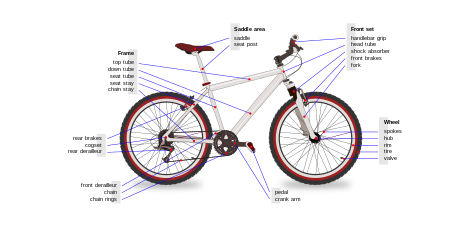Skirt guard


A skirt guard, dress guard or coat guard is a device fitted over the rear wheel of a bicycle to prevent a long skirt, coat or other trailing clothes or luggage catching in the wheel, or in the gap between the rim and the brakes.
These guards also help prevent a child's foot becoming entangled in the spokes, when they are seated on a rear child seat or directly on a rear rack.[1]
Skirt guards are common on bicycles in continental Europe, where the bicycle is commonly ridden in smart-casual or formal clothing; but very uncommon in English-speaking countries where many cyclists wear specialised cycling gear. It is often paired with a chain guard to keep the rider's clothing clean. They are often used on utility bicycles.
There are several forms, for instance:
- A length of string may be threaded through holes in the rear mudguard, running radially between the mudguard and the rear dropout.
- A lightweight metal mesh covering the upper half of the rear wheel.
- A fabric mesh or net stretched over the same area.
- A flexible canvas secured over the same area.
- A solid, rigid metal or plastic plate, which can be smaller than a canvas piece.
Large, solid surfaces have the disadvantage of air resistance, which increases the risk of being blown sideways by gusty sidewinds. Air-permeable designs such as mesh and string provide a more stable ride, but can be more difficult to keep clean. A pair of small plastic sheets gives moderate air resistance and a smooth surface which is easier to keep clean.
See also[edit]
References[edit]
- DK (17 May 2016). Bicycle: The Definitive Visual History. DK Publishing. pp. 58–. ISBN 978-1-4654-5530-7.
- ^ "National Consumer Affairs Center of Japan - Be careful! Children's feet might be caught in the wheel while double riding; Bicycle spoke injuries have frequently occurred". Archived from [kokusen.go.jp/e-hello/news/data/n-20160818_1.html the original] on 2019-07-24. Retrieved 2020-02-10.
{{cite web}}: Check|url=value (help)

